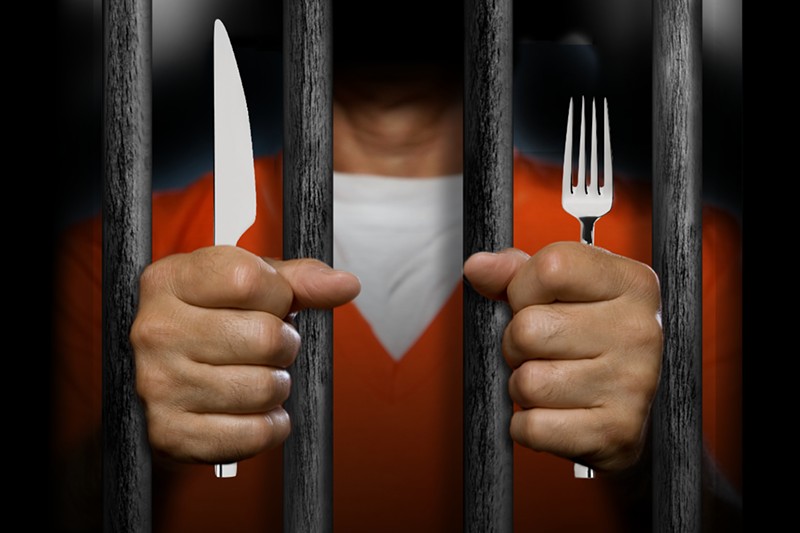In lieu of a serving of the lukewarm slop — what some deem "inedible" — that is fed to people incarcerated at the Arizona State Prison Complex in Florence, Hooper enjoyed extra-crispy fried chicken from KFC. Also on his menu was hot macaroni and cheese, a buttery dinner roll, succulent cheesecake, two whole pints of Neapolitan ice cream, and a large glass of orange soda.
Fifteen hours later, executioners killed him in a tiny cinderblock room.
Hooper was convicted of a 1980 double murder in Phoenix. He spent 39 years, the majority of his life, on death row, where he was underfed and malnourished. According to a June report from the Prison Journalism Project, “food quality at the Arizona State Prison Complex in Florence has been steadily declining.”
Incarcerated people there are often served eight or more slices of cheap sandwich bread per day, equating to more than 250 loaves of crappy bread every year. They don’t eat a whole lot else. And much of what they do eat — which is high in carbohydrates, salts, and sugar — exacerbates existing health issues, including diabetes and heart disease, according to the ACLU.
So, what do you have in common with a convicted double-murderer who spends 22 hours a day inside an 8-by-12-foot cell eating a bland concoction called “soy base stew”? Likely, nothing — except maybe food.
A Phoenix New Times analysis of data from the Arizona Department of Corrections highlighted some interesting trends among the last meal requests of people executed in the state since 1992 — 40 men in all. Most wanted large dinners, they sought nostalgic or regional childhood foods, and some seem to have forgotten there are things beyond the prison menu.
The data paints a vivid picture of hunger, injustice, psychology, and palate on death row.
‘A Fundamental Human Rights Issue’
The centuries-old ritual of a last meal offers people on the outside “a poignant human connection to the people they have decided should die for their crimes,” Fordham Law School professor Deborah Denno told BBC Radio. "It brings us back to the fact that this is a human being who will not be having any more dinners like we do.”The irony is that Americans en masse accept the last meal as a fundamental human right but don’t see insulin-resistance or vegetarian diet — things that have been outright denied to people with diabetes and followers of Hinduism in Arizona prisons, for example — on equal footing with it. In 2019, an Arizona federal district court dismissed an incarcerated person’s complaint that he was denied religious meals.
“If we think this is a choice that people deserve for their last meal, why not every meal?” asked Alex Busansky, president and founder of the Oakland, California-based research center Impact Justice, in an interview with New Times.
In 2019, Busansky launched the Food in Prison Project, a comprehensive study focused on what's served in U.S. prisons. In 2020, he published Eating Behind Bars, which explored how prison food is used as both a punishment and a recompense, as it is on death row. In November, he authored an essay titled The Deeper Meaning of Food In Our Lives in which he explored the stark disparity between the cultural understanding of food inside and outside prison walls.
In Eating Behind Bars, Busansky wrote that "food is a fundamental human rights issue,” and upholding the Salem Witch Trial-era tradition of a last meal, by contrast, highlights the many real human rights violations that incarcerated people suffer every day.
“The idea that somehow one last meal will erase a history of physical abuse, abuse by the legal system, a lifetime of incarceration, and somehow everyone is ending up on a positive note — I think it is a myth that is perpetuated in literature, media, and other places,” Busansky told New Times.
Hooper’s case highlights this point well. It was a case mired in allegations of police misconduct. Hooper initially admitted to police he was involved but later maintained his innocence until his execution.
No physical evidence tied Hooper to the scene of the crime.
‘Unappetizing and Unhealthy’

Murray Hooper, executed in November, was the only inmate in Arizona since 1992 to request water to drink as part of his last meal.
Arizona Department of Corrections
For the last decade, people housed in Maricopa County jails have been given only two meals a day, which offer little sustenance. For breakfast on weekends, they receive a meager peanut butter and “grape-flavored jelly” sandwich with a few cookies, a piece of fruit, and the tiny carton of milk you might associate with a kindergarten classroom. For dinner, their only other meal of the day, people in the jails get the same thing again, minus the milk.
For incarcerated people, prisons are “sending the message that they are less than human every time they sit down to a meal,” Busansky said. “Not only is the food in prison unappetizing and unhealthy by every definition, but even in crowded chow halls, meals are a solitary experience, not a communal one. People sometimes have just minutes to eat, are required to eat in silence, and sharing food — when there is anything worth sharing — is usually prohibited.”
Maybe that’s why the average person on death row in Arizona requests seven different food items for their last meal, according to the records obtained by New Times.
In the past few decades, people on death row have requested a variety of items, ranging from an entire block of cheese to a bottle of Rolaids and even dog meat. Some declined to make a request for their last meal, while others ordered a full menu but didn’t touch their plate. There’s a rich subtext when it comes to the final hankerings of people on the brink of death.

Ice cream was the most common dessert requested by the 40 people executed in Arizona since 1992.
Brett Stevens / Image Source / Getty Images
Comfort Food
Some 62 percent of incarcerated people had never laid eyes on a fresh vegetable during their time in prison, according to a 2020 survey by Busansky of previously incarcerated people in the U.S. This was the most requested food item among people who have been executed in Arizona, followed by french fries, plain bread, fried eggs, and breakfast meats. The most sought-after fresh vegetables? Whole jalapeños.Other popular dinner items included potatoes, tacos, burritos, hamburgers, and fried seafood. Five people asked for the same dull sandwiches they’re served every day — peanut butter and jelly, or deli meat with mayonnaise and mustard.
Ice cream was requested 17 times, making it the most common dessert. The most popular flavor was vanilla, followed by strawberry, rocky road, peppermint, and pineapple sherbet. Eight people asked for pie, with apple being the most common request, and five people wanted cake.
Hooper was the first and only person on death row to ever ask for water to drink. The most common drink to accompany a last meal has been soda, which was requested 18 times. Pepsi was the most common ask, followed by Coke, then Dr. Pepper and cream soda. Plenty of others asked for milk, juice, coffee, and malts.
At a glance, last meal requests have been uniquely American fare. People on death row wanted biscuits and gravy, cranberry sauce, cole slaw, clam chowder, and macaroni and cheese. For many of them, the last meal is their final chance to reconnect with a dimming nostalgia from days before incarceration, Busansky said. It’s a comfort thing.
“The comfort foods of our life are not lobsters and caviar,” Busansky said. “Lobsters and caviar — that’s the values of people on the outside. Not people on the inside.”
The largest last meal request contained 13 different menu items. John Brewer, who strangled his girlfriend to death in the couple's Flagstaff apartment in 1987 and was executed in 1993, received this final repast: grilled pork chops with gravy, a quarter-pound of bacon, six fried butterfly shrimp, beef Rice-a-Roni, three slices of French bread with butter, applesauce, two cans of Canada Dry Ginger Ale with ice, one slice of coconut cream pie, a pint of orange juice, a can of chicken noodle soup with crackers, one can of halved pears with syrup, and Maxwell House coffee with cream and sugar. That's a total of 3,770 calories.
The biggest request by calories, though, came from William Woratzeck, who stabbed and beat his young female tenant to death in Pinal County in 1980 and was executed in 1997. He consumed more than 7,100 calories before he died by lethal injection: a 16-ounce top sirloin steak cooked medium rare, french fries, onion rings, a dozen deep-fried butterfly shrimp, an entire cherry cheesecake, a whole case of Pepsi, and a pot of hot coffee.
The smallest request came from Joseph Wood, who was executed in 2014 after murdering his estranged girlfriend and her father in Tucson in 1989. He asked for only two cookies.

Last meal requests from people on Arizona's death row are typically for cheap, ordinary food.
Katya Schwenk
‘It’s Not Your Birthday, It’s Your Death Day’
According to a 2014 article by Sarah Gerwig-Moore, a professor at Mercer University School of Law in Macon, Georgia, the tradition of a last meal stretches “back across centuries of United States history and before." In ancient Greece, people were fed a large meal before they were executed to prevent them from coming back to haunt the mortal realm as a hangry ghost. Puritans in Massachusetts held grand feasts for those who would be executed, “believing it emulated the Last Supper of Christ, representing a communal atonement for the community and the prisoner,” Gerwig-Moore wrote.Experts agree that the last meal offering is upheld broadly because of this tradition rather than practicality. In 2011, a prominent Texas senator helped end the last meal tradition in that state after a person on death row requested two chicken fried steaks, a triple-meat bacon cheeseburger, fried okra, a pound of barbecue, three fajitas, a meat lover's pizza, a pint of ice cream, and a slab of peanut butter fudge with crushed peanuts — and ate none of it.
That year, New Times wrote that “death row last meals may be becoming a thing of the past” and cited the Texas decision. But all three people executed in Arizona in 2022 — Frank Atwood, Clarence Dixon, and Hooper — chose a last meal. There’s no sign of the tradition coming to an end here, according to a corrections department spokesperson.
“There is a romantic notion of it in film, TV, and literature about the last meal,” Busansky said.
In the 2021 film Last Meal, a person in prison must cook the last meal of another to get enough community service time to leave. In an earlier 2018 film of the same name, the protagonist dreams of being the next great celebrity chef, but his lofty aspirations are jeopardized when controversy arises surrounding his current job: cooking last meals for prisoners on death row. And in the 2015 film The Bronx Dahmer, old-school pizza proprietors wax derisive as their cuisine fulfills the last meal request of a person on death row.
The reality for last meals on death row in Arizona is less romantic. All but three of the 40 people executed in the state since 1992 detailed their last meal requests on Form 710-5, which the corrections department pledges to make “every reasonable effort to accommodate." Yet, the requests are mostly for cheap and ordinary food.
Six people requested powdered juice drinks and nine requested instant coffee, even though fresh-pressed juices and artisan espresso drinks are fair game. Others requested knockoff cola brands and penny foods like ramen, a high-value item in the prison commissary.
“How they think about food might be different,” Busansky said of the people requesting their last meals. “For your birthday, you get excited about your special meal. I’m not sure you get excited about your last meal when you’re about to be put to death — especially when you’re innocent.”
Unlike other meal-choosing occasions outside of the context of incarceration, the last meal isn’t a high point that invokes cravings for lobsters or caviar, white truffles, or Wagyu beef.
“It’s not your birthday, it’s your death day,” Busansky said. “People don’t approach food the same way.”

Among 40 people executed in Arizona since 1992, six people requested powdered juice drinks and nine requested instant coffee.
Katya Schwenk
Plain Bread
According to the data obtained by New Times, the third-most requested food item among people on death row is plain bread. That’s already the primary feature of their daily prison diet.The choice could be the result of growing accustomed to prison meals, nostalgia, and a fading memory of what food is like in the outside world, according to experts. “They’ve spent years not getting enough,” Busansky said. “The stuff they get is not good in terms of quality and taste. They’ve had no choice.”
People on death row are underfed with such low-quality food that even fast food and knock-off options seem like incredible treats after decades behind bars. Michael Poland, who with his brother murdered two courier guards in Cottonwood in 1977, relished in a final beverage of dollar-store instant coffee powder before he was executed in 1999. His brother and accomplice, Patrick Poland, declined his last meal request ahead of his execution a year later.
“People have been in there for a long time,” Busansky said. “That might have a factor in it.”
Rare efforts by corrections officials to offer special meals come up short, too. In 2018, people housed at the Arizona State Prison Complex – Perryville in Goodyear were given a Christmas dinner of roast beef, mashed potatoes with gravy, broccoli, stuffing, and pumpkin pie.
One incarcerated person described the roast beef as “so tough you could have re-soled your shoes with it.” The broccoli was “all shredded stems, boiled to the consistency of glue,” the person added. “Not one floret survived.” The hockey puck masquerading as stuffing, she said, was made of “two butt ends of an old loaf of bread soaked in water.”
A few months later, New Times revealed the Perryville prison served chicken that was labeled “not for human consumption.”
For people on death row who spend decades of their lives in prison, this brings about an unsavory association with some of the dishes they used to love. It grows harder and harder to eat food not only out of hunger but also for enjoyment.
“You hear about people who leave prison after many years, and they are overwhelmed by the amount of choice they are presented with,” Busansky said. “Here, you are giving people a choice for the first time in an institution where they have had tens of thousands of meals with no choice. Your experience with food has not supported or enhanced your desire for certain things.”












